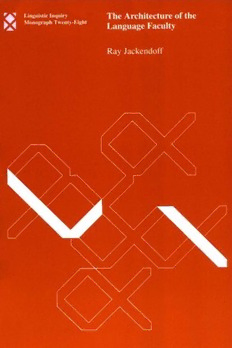
The Architecture of the Language Faculty (Linguistic Inquiry Monographs) PDF
278 Pages·1997·7.55 MB·
Most books are stored in the elastic cloud where traffic is expensive. For this reason, we have a limit on daily download.
Preview The Architecture of the Language Faculty (Linguistic Inquiry Monographs)
Description:
Since the 1970s, Ray Jackendoff has investigated many complex issues in syntax, semantics and the relation of language to other cognitive domains. He steps back in this book to survey the broader theoretical landscape in linguistics, in an attempt to identify some of the sources of the widely perceived malaise with respect to much current theorizing. Starting from the "Minimalist" necessity for interfaces of the grammar with sound, meaning and the lexicon, Jackendoff examines many standard assumptions of generative grammar that in retrospect may be seen as the product of historical accident. He then develops alternatives more congenial to contemporary understanding of linguistic phenomena. "The Architecture of the Language Faculty" seeks to situate the language capacity in a more general theory of mental representations and to connect the theory of grammar with processing. To this end, Jackendoff works out an architecture that generates multiple co-constraining structures, and he embeds this proposal in a version of the modularity hypothesis called "Representational Modularity". Jackendoff carefully articulates the nature of lexical entries, including idioms and productive affixes. The resulting organization of the grammar is compatible with many different technical realizations, which he shows can be instantiated in terms of a variety of current theoretical frameworks.
See more
The list of books you might like
Most books are stored in the elastic cloud where traffic is expensive. For this reason, we have a limit on daily download.
